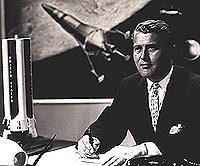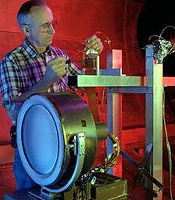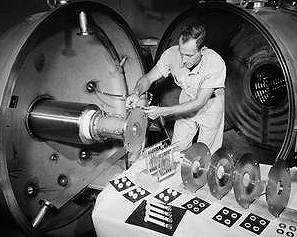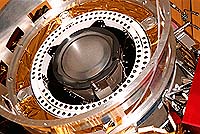 Space Science News home |
|
Right: An artist's concept depicts the Deep Space 1 probe with its ion engine operating at full thrust. (Links to 571x377-pixel, 33K JPG). In 1932, the German Army's Ordnance Department provided him with a research grant to test small liquid-fueled rocket engines at the Kummersdorf Proving Grounds near Berlin. During World War II, he and a team of German rocket experts developed the V-2 rocket, a14.4-meter (47-ft) high missile that burned liquid oxygen with alcohol (made from fermented potatoes). |
 In 1948, the orginal "German Rocket Team" posed for a group portrait at Fort Bliss, Texas. Dr. Ernst Stuhlinger is circled to the left of center. Dr. Wernher von Braun is circled at right. Two years later, they relocated to Huntsville, Ala. |
|
At the end of WWII in 1945, von Braun and hundreds of other German rocket experts surrendered to the Americans. They were sent to Fort Bliss, Texas, to develop rocket technology for U.S. Army research. While von Braun and his team continued to work on the V-2 rocket at Fort Bliss, von Braun dreamed about developing a rocket that could travel to other planets. With that thought in mind, he approached Ernst Stuhlinger, a member of the original "Rocket Team" that had emigrated to Fort Bliss. Von Braun asked Stuhlinger to review the research by von Braun's mentor, Oberth. |
|
"Professor Oberth has been right with so many of his early proposals," von Braun told Stuhlinger in 1947, "I wouldn't be a bit surprised if we flew to Mars electrically." Stuhlinger immersed himself in electric propulsion theory. He found a copy of Oberth's book, "Possibilities of Space Flight." Published in 1939, Oberth devoted a chapter to the various problems of electric propulsion systems, envisioning one design that might carry a 150-ton payload. In studying the origins of interest in electric propulsion, Stuhlinger learned that the American rocket pioneer, Dr. Robert Goddard, had examined the subject as early as 1906. Goddard had mentioned the possibility of accelerating electrically charged particles to very high velocities without the need for high temperatures. Studies in electric propulsion became more frequent following WWII, and in 1955 Stuhlinger presented a paper at the International Astronautical Congress in Vienna entitled, "Possibilities of Electrical Space Ship Propulsion." During his presentation, Stuhlinger discussed a proposal made by von Braun two years earlier, to use chemical propulsion to send a spaceship to Mars. In von Braun's proposal, Stuhlinger noted that the ratio of take-off weight to final weight after propellant consumption was 25-to-1. Stuhlinger argued that lighter-weight electric propulsion systems would make such planetary trips more feasible than they were with chemical propulsion. |
|
 In 1950, the Army
decided to expand its work on missiles and rockets. The Army
moved its rocket team, including von Braun, Stuhlinger, and other
members of the German team, to Redstone Arsenal in Huntsville,
Ala. Together, these scientists built the Redstone missile, which
was adapted to be the Jupiter-C rocket. The Jupiter-C launched
Explorer 1, America's first satellite, in 1958. In 1960, von
Braun and his team transferred to NASA, forming the nucleus of
the new Marshall Space Flight Center in Huntsville. In 1950, the Army
decided to expand its work on missiles and rockets. The Army
moved its rocket team, including von Braun, Stuhlinger, and other
members of the German team, to Redstone Arsenal in Huntsville,
Ala. Together, these scientists built the Redstone missile, which
was adapted to be the Jupiter-C rocket. The Jupiter-C launched
Explorer 1, America's first satellite, in 1958. In 1960, von
Braun and his team transferred to NASA, forming the nucleus of
the new Marshall Space Flight Center in Huntsville.
Dr. Wernher von Braun in a 1961 portrait. The painting behind him depicts an early lunar lander concept, Project Horizon, studied while he was with the Army. |
|
San Antonio -- April 6, 1999 -- Scientists and engineers from Southwest Research Institute (SwRI) and the Los Alamos National Laboratory have announced initial results from the novel PEPE instrument carried on the Deep Space 1 (DS1) spacecraft, part of NASA's New Millennium Program. According to Dr. David Young of SwRI, the principal investigator for the data analysis phase of the DS1 mission and spokesman for the PEPE team, the new instrument observed charged xenon particles returning to the spacecraft from the 1 ampere exhaust plume of the ion propulsion jet. At the same time, PEPE data have been used to place limits on electrical charging of the DS1 spacecraft. Taken together, these data suggest that the ion drive engine used to propel the spacecraft can indeed be used to power future scientific missions without interfering with the scientific payload. Before now, the use of such an engine in space had been unproved. PEPE incorporates a half-dozen new technologies that will make future space plasma instruments smaller and less expensive. Among these is a novel time-of- flight mass spectrometer that measures the composition of charged atomic particles (ions) coming from asteroid 1992 KD, the target of the DS1 mission. Other technologies include high performance power supplies operating at up to 15,000 volts but weighing just over 100 grams. PEPE also incorporates novel ion and electron optical systems that eliminate complex motors otherwise needed to steer a plasma instrument's line of sight. Young said that PEPE has achieved most of its technical goals: It weighs about 25 percent of the mass and uses 50 percent of the power of a comparably performing SwRI instrument on NASA's Cassini spacecraft, while costing about 75 percent less. During January, the PEPE team took advantage of favorable alignment of the DS1 and Cassini spacecraft to measure the solar wind at both locations while separated by a distance of nearly 40,000,000 miles. Young indicated that these initial PEPE measurements of the solar wind confirm that the instrument will be able to detect extremely low densities of ions and electrons during the planned DS1 encounters with the asteroid. For ions, the lowest detectable density is about 1 ion per 100 cubic centimeters, and for electrons it is ten times less. This means that PEPE has a good chance of providing the first plasma sensor detection of an asteroid and should give the first indication of the composition of asteroid surface materials that are constantly knocked off the asteroid surface by the solar wind. SwRI is an independent, nonprofit, applied research and development organization with more than 2,700 employees and an annual research volume of more than $300 million. |
Left: A Saturn 5 rocket launches Apollo 8 to the moon in 1968. The Saturn 5 still is the high point of large rockets, but it is far from the most efficient in a "miles per gallon" sense. James A. Downey, a NASA retiree who started with the Army rocket team, traced the Army's and NASA's development of electronic propulsion. He reported that the most imposing problem in the early development of ion engines was proving that injecting electrons could neutralize an ion beam. Continually spewing positively charged ions will leave a spacecraft with a negative charge so great that the ions are attracted back to the spacecraft. The solution is an electron gun that dumps the electrons into the ion stream, thus neutralizing both spacecraft and exhaust. But the beam's interaction with the walls of even a large vacuum chamber makes it very difficult to conduct meaningful beam neutralization experiments on Earth. According to Downey, these uncertainties led to considerations for flight testing electric engines. Downey said another challenge of electronic propulsion involved developing an efficient technique to produce ions. Working at NASA/Lewis, Harold Kaufman invented an electron-bombardment technique to ionize mercury atoms. At NASA/Marshall, they were developing a process where cesium atoms would become ionized upon contact with a hot tungsten or rhenium surface. Marshall's major development in electrical propulsion centered, however, on a 30-kilowatt ion engine development contract, initiated in September 1960 with Hughes Research Laboratory in Malibu, Calif. At first, Marshall directed Hughes to design a laboratory model of an ion engine. The 0.01 lb.-thrust model would be followed by the development of a 0.1 lb.-thrust engine. Marshall later modified the Hughes contract to include a flight test model ion engine, primarily to determine whether a beam neutralization problem existed in space. |
|
Right: A NASA engineer prepares an early ion engine for a vacuum chamber test in 1959. Lined up at right are the major electrical parts. Hughes demonstrated an ion engine on Sept. 27, 1961, at its research laboratories in Malibu. Stuhlinger was among those on hand to greet the scientific and technical writers who attended the event. The group gathered to watch the engine actually operate in a vacuum chamber intended to duplicate the conditions the engine would encounter in space. Less than two months after the demonstration, however, NASA announced the consolidation of its nuclear-electric propulsion programs at Lewis. Nuclear-electric propulsion work at the Marshall Center's Research Projects Division, directed by Stuhlinger, moved from Huntsville to Cleveland. Stuhlinger, though, stayed at NASA/Marshall and worked on other projects. "The urgency of Marshall's work on NASA's lunar and manned space flight programs prompted the decision to employ Stuhlinger's group exclusively on those projects," one agency report stated. The nation was focused on sending a man to the moon using chemically propelled rockets. |
In the early 1990s, the Jet Propulsion Laboratory and NASA/Lewis partnered on the NASA Solar Electric Power Technology Applications Readiness (NSTAR) project. The purpose of NSTAR was to develop xenon ion engines for deep space missions. In June 1996, a prototype engine built by NASA/Lewis began
a long-duration test in a vacuum chamber at JPL simulating conditions
of outer space. The test concluded in September 1997 after the
engine successfully logged more than 8,000 hours of operation.
Results of the NSTAR tests were used to define the design of
flight hardware that was built for Deep Space 1.
Although responsibility for electric propulsion research has moved from Marshall to Lewis, Stuhlinger still continues to promote the promises of electric propulsion. "Everyone who ever worked on electric propulsion during these past 50 years is now following the newest ion propulsion project, Jet Propulsion Laboratory's Deep Space 1 mission…with greatest interest, and with fervent wishes for success," Stuhlinger says. |
|
Deep Space 1 - Jet Propulsion Lab's Mission
Page |
|
More  Headlines Headlinesreturn to Space Science News Home
|

 The
principle behind the Deep Space 1 engine is much the same as
what you experience when you pull hot socks out of the clothes
dryer on a cold winter day. The socks push away from each other
because they are electrostatically charged, and like charges
repel. The challenge in electric space propulsion is to charge
a fluid so its atoms can be expelled in one direction, and thus
propel the spacecraft in the other direction.
The
principle behind the Deep Space 1 engine is much the same as
what you experience when you pull hot socks out of the clothes
dryer on a cold winter day. The socks push away from each other
because they are electrostatically charged, and like charges
repel. The challenge in electric space propulsion is to charge
a fluid so its atoms can be expelled in one direction, and thus
propel the spacecraft in the other direction.
 Work on electric propulsion in
Huntsville centered on ion engines. In April 1958, the Army Ballistic
Missile Agency in Huntsville initiated its first electrical propulsion
contract. Stuhlinger and his fellow scientists selected Electro-Optical
Systems (EOS), Inc. to investigate ion thrust devices.
Work on electric propulsion in
Huntsville centered on ion engines. In April 1958, the Army Ballistic
Missile Agency in Huntsville initiated its first electrical propulsion
contract. Stuhlinger and his fellow scientists selected Electro-Optical
Systems (EOS), Inc. to investigate ion thrust devices. On Aug. 1, 1961,
NASA awarded a contract to the Astro-Electronics Division of
RCA to design and build a payload capsule for flight-testing
electric propulsion engines. The program called for seven capsules,
three for ground tests and four for actual flight tests. Each
capsule was expected to carry two electric engines. The first
was expected to carry one cesium-fueled ion-engine representing
Stuhlinger's design with the Hughes engine. The second was expected
to carry one mercury-fueled ion engine representing Kaufman's
design with the Lewis engine. Plans called for the engines to
operate from 1 to 2 kW of power.
On Aug. 1, 1961,
NASA awarded a contract to the Astro-Electronics Division of
RCA to design and build a payload capsule for flight-testing
electric propulsion engines. The program called for seven capsules,
three for ground tests and four for actual flight tests. Each
capsule was expected to carry two electric engines. The first
was expected to carry one cesium-fueled ion-engine representing
Stuhlinger's design with the Hughes engine. The second was expected
to carry one mercury-fueled ion engine representing Kaufman's
design with the Lewis engine. Plans called for the engines to
operate from 1 to 2 kW of power. Right: The camera takes a peek at the exhaust grid
(center) of the DS1 engine, inside the support skirt, shortly
before its launch (right).
Right: The camera takes a peek at the exhaust grid
(center) of the DS1 engine, inside the support skirt, shortly
before its launch (right).